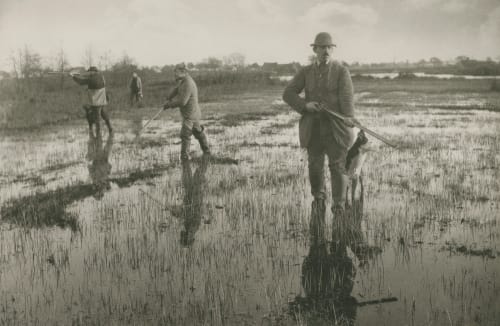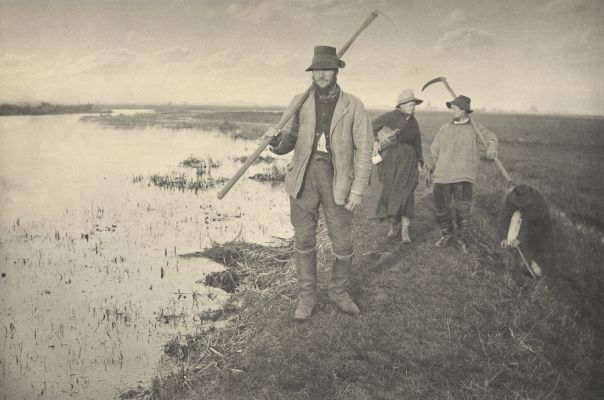
Title
Snipe ShootingArtist
Emerson, Peter Henry (British, 1856-1936)Key FigurePublication
Life and Landscape on the Norfolk BroadsDate
1885Process
PlatinumImage Size
28.5 x 18.7 cm
This platinum print is from Peter Henry Emerson’s, Life and Landscape on the Norfolk Broads. Drawn to rural subjects, Emerson was fascinated by the region’s traditional ways of life and concerned that they were threatened by industrialization and tourism. From 1885 to 1895 Emerson documented the region’s traditions and landscape, which he felt was in danger of disappearing.
Originally introduced to photography on bird-watching trips, Emerson’s work reflects the influence of the Realist school of painting, incorporating a photographic and specifically English sensibility into their artistic celebration of peasant lifestyles. Emerson was an early proponent of straight photography as an art form, eschewing both the undiscriminating emphasis of sharp focus rendering and the romantic vagueness of soft focus. Emerson’s subjective approach was enhanced by the ‘ambiance’ of selective focus which aimed to replicate the experience of the human eye’s encounter with the world. His vocal advocacy of this ‘truthful’ photography saw him rise to a position of considerable and controversial influence within the contemporary photography establishment. His influential 1889 book Naturalistic Photography for Students of the Art outlined his thesis that photography’s ability to record nature truthfully was its most expressive one. He argued that the photograph should imitate nature rather than alter it.
Life and Landscape on the Norfolk Broads, published in 1886, consisted of 40 platinum prints. Experiencing difficulty with accurately recreating the depth and atmosphere which he saw as necessary to capture nature with precision, Emerson explored photogravure. After Life and Landscape, he published seven further books of his photography through the next ten years – all in photogravure. In the last two of these volumes, On English Lagoons (1893) and Marsh Leaves (1895), Emerson printed the photogravures himself. After the publication of Marsh Leaves in 1895, generally considered to be his best work, Emerson published no further photographs.
Reproduced / Exhibited
Middleton, C S, Payne Jennings, P H. Emerson, and G C. Davies. The Broadland Photographers. Norwich: Wensum Books, 1978.
Newhall, Nancy. P. H. Emerson: The Fight for Photography As a Fine Art. New York: Aperture, 1976. p. 219.
MOMA Object number 543.1967.10
Getty Object number 84.XB.696.4.11
National Gallery of Art 1995.63.1.j
MET Accession Number: 2008.669 (1–40)
References
Newhall, Nancy. P. H. Emerson: The Fight for Photography As a Fine Art. New York: Aperture, 1976. p. 189.
Carl Fuldner, ‘Emerson’s Evolution’, Tate Papers, no.27, Spring 2017, http://www.tate.org.uk/research/publications/tate-papers/27/emersons-evolution, accessed 26 July 2017.
Taylor J. The Old Order and the New : P.H. Emerson and Photography 1885-1895. Munich: Prestel; 2006.

